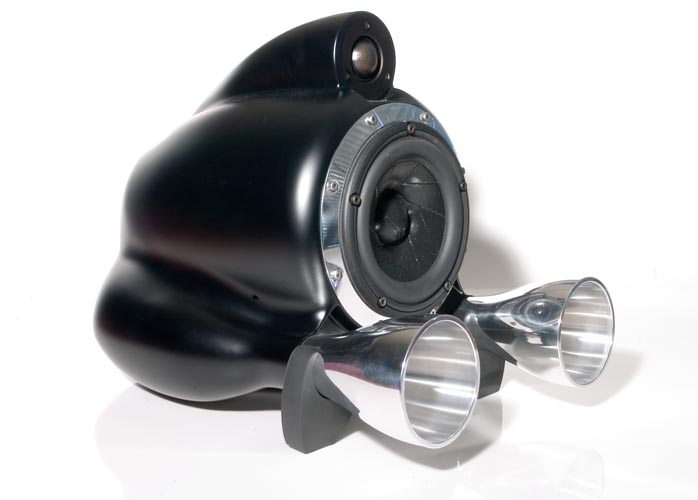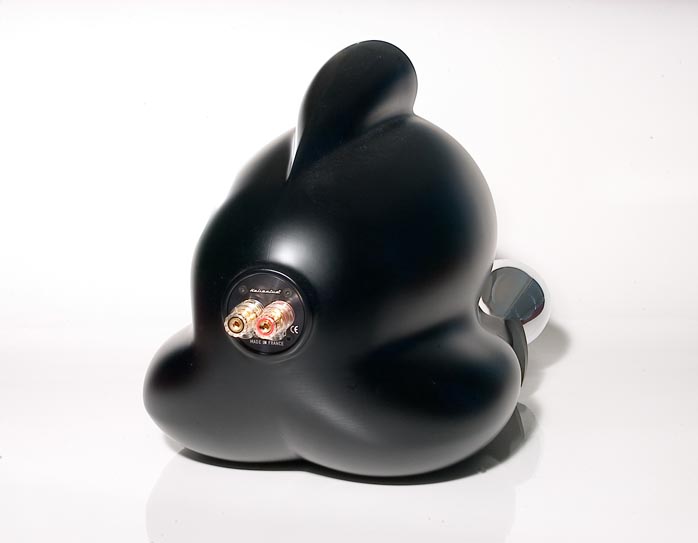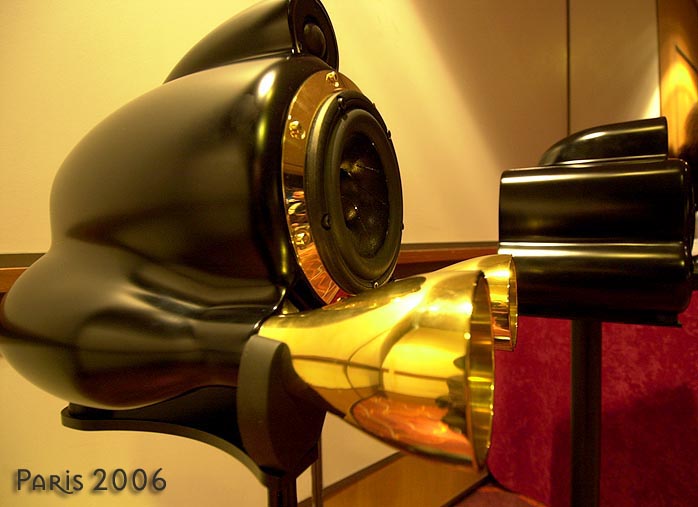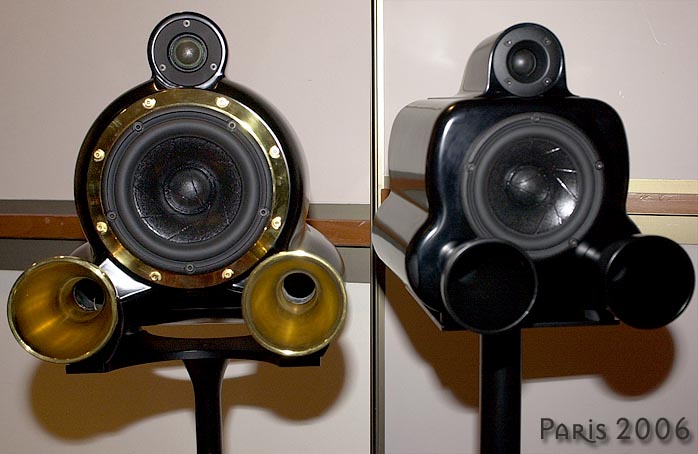|
This review page is supported in part by the sponsor whose ad is displayed above
|
|||||||||||||||
 |
|||||||||||||||
 |
|||||||||||||||
Reviewers: Marja & Henk Sources: CEC TL5100, Audio Note tube DAC, Philips DVP 5500S SACD/DVD player Preamp/integrated: TacT RCS 2.0 room control system; modified Audio Note Meishu with AVVT, JJ or KR Audio 300B output tubes; Moscode 401HR [in for review]; Trends Audio TA-10 [on review] Speakers: Avantgarde Acoustic Duo Omega; Avantgarde Acoustic Solo in HT 2.0 setting; Audio Note AN/Jsp silver-wired; Quad ESL 2905 [in for review]; Von Schweikert VR5-SE [in for review]; Haliaetus Firebird [in for review] Cables: Audio Note AN/Vx interconnects; Siltech Paris interconnects; Gizmo silver interconnect; Qunex 75 reference interconnect; Crystal Cable CrystalConnect Reference interconnect, CrystalDigit S/PDIF RCA/RCA and RCA/BNC, Y-cable, Crystal Cable Piccolo iPod to XLR, CrystalPower Reference AC-Eur/IEC; CrystalSpeak Reference, Audio Note AN-L, Gizmo silver LS cable; Virtual Dynamics Revelation power cords [in for review], Bocchino Morning Glory [in for review], Harmonic Technology Magic Woofer, Magic Tweeter & Pro AC11 [in for review] Power line conditioning: Omtec PowerControllers Equipment racks: Two double sets of Solid Tech Radius Sundry accessories: IAR carbon CD damper; Denson demagnetizer CD; Nespa #1; TacT RCS calibrated microphone and software; Exact Audio Copy software; Compaq server w/Windows Server 2003 and XP; wood, brass and aluminum cones and pyramids; Xitel surround processor; Manley Skipjack; Boston Audio Design TuneBlocks, Nespa Pro [in for review]; Furutech DeMag Room treatment: Acoustic System Resonators; Gizmo's Harley Davidson cap Review Component Retail: € 8,000/pr |
|||||||||||||||
 |
|||||||||||||||
Loudspeakers come in all manner of shapes and sizes. For wide frequency response i.e. a low F3, the cabinet must be large to facilitate low frequencies. An enclosure loading based on the Helmholtz resonator adds a port opening in the cabinet. A side effect of a cabinet with a hole in it is the fact that its emerging pressure wave is out of phase with the direct pressure wave of the driver into the room. By adding a tunnel to the hole, it is possible to slow the airflow in the port. By choosing the correct length and diameter, the phase of the wave can be manipulated to sync it up with the direct radiation's phase. Using a vented system not only makes possible a smaller cabinet for equivalent bass extension but can also reduce the diameter necessary for the bass driver. A vented or ported speaker enclosure is often called a bass reflex system. |
|||||||||||||||
 |
|||||||||||||||
Another form of venting a cabinet is by transmission line. Instead of using a port and its tunnel wave guide to enhance bass response, a transmission line uses an internal labyrinth to absorb the driver's rear wave. The terminus of a fully absorptive transmission line will not vent any audible energy. In general, a relatively small cabinet with a small driver performs better -- or is easier to design -- when vented. A smaller cabinet is also easier to handle during fabrication and be made rigid with less expense. However, vented alignments have their own problems. At low outputs, the vents will handle the pressure release but as signal amplitude increases, the port will become a restriction and induce chuffing noise. Increasing the port diameter increases how much air can be processed but the box tuning now changes. The internal cabinet volume, port diameter and port length are all interconnected. To combat certain high-pressure scenarios, loudspeaker makers have looked at different vent shapes and ways to flare the ends of the port tube - exponential, with dimples, with rounded edges etc. |
|||||||||||||||
 |
|||||||||||||||
The noise from vented systems is caused by air turbulence. Such turbulence occurs when the port's pressurized airflow hits the static air outside the port. The science of aerodynamics deals with exactly such turbulences. Airplanes only operate -- i.e. lift off and remain in the air -- if the turbulence on their wings is controlled. Enter Jean-Pierre Morkerken, a French engineer working at the Laboratoir d'Acoustique Musicale of the Parisian university of Pierre et Marie Curie. Besides his work at the university, Jean-Pierre used to be a pilot. Hence three interests converge in one person - aerodynamics, music and acoustics. Is it a surprise then how this would lead to a research project on designing the best vented loudspeaker? During his years of research, Jean-Pierre and his students worked their way through various designs. Their goal of a small speaker capable of producing enough bass without the commonly associated turbulence issues soon developed into a unique design. They quickly realized that in a conventional vented cabinet, the diameter of the port is far smaller than that of the driver loading it. The concomitant compression of the port means that the air speed in it is far greater than that excited by the speaker membrane in the room. Besides wishing to equalize that ratio with vents whose aggregate diameter would more closely approximate that of the woofer, they also had to deal with the relative location of the port via the driver and the coupling effects between the two. |
|||||||||||||||
 |
|||||||||||||||
To tackle the coupling effect while retaining as small a cabinet as possible, the researchers experimented with extending the port outside the enclosure to net greater lengths and lower the port tuning frequency. They crafted an 8-liter rectangular box prototype with a 15cm mid/woofer and two pipes. Each pipe shared its length equally between the inside and outside of the box. This setup improved the coupling effect and enhanced the enclosure's bass response. Still, turbulence persisted on both ends of the pipes. Worse, those at the mouth fired back inside and created vortices in turn. A better way to attack the turbulence than enlarging the vent diameter is to decrease the air velocity on each side of the vent. This approach gave rise to what was to become the signature look of the Haliaetus loudspeaker - the nozzles. Aeronautic research performed at sites like the European Space Agency or ESA in Noordwijk/Holland had resulted in empirical data that led to nozzle designs of remarkable properties. Under the correct circumstances, nozzles can accelerate air flow just behind the neck of the nozzle to speeds higher than the speed of sound. When Morkerken and his team used an adapted machined aluminum nozzle in their prototype loudspeaker, the results were very promising. They measured a 4dB increase of output at 70Hz with their small 8-liter cabinet and far lower distortion. Researching further, they optimized dimensions and locations for the woofer and its nozzles. Important was the phase behavior of the combination. It appeared that by using a nozzle for a vent, the air in the vent could be made to behave as a fluid rather than compressed air. The nozzle's operation further had a positive effect on controlling the speaker cone so higher SPLs at low frequencies became feasible. |
|||||||||||||||
 |
|||||||||||||||
 |
|||||||||||||||
Well, enough of scientific research which nonetheless might prove that audio is partially rocket science. After setting an initial review appointment at the Munich High End show, we confirmed delivery dates at the following Paris show. We could do so because the research project had become a fully fledged company by now. Jean-Pierre Morkerken believed in his nozzle loading so much that he set up Haliaetus Technologies together with Raphael de Thoury. Their first commercial product is the HA-325 Firebird under consideration. The Firebird is rated at 87dB sensitivity and 6 ohms. The external dimensions are 310 x 270 x 400 millimeters and the speaker weighs a mere 6kg. Its sensuously rounded shapes and beautiful matte finish cover an 8-liter cavity. Below the 14.8cm Scanspeak mid/woofer protrude the two aluminum nozzles while hiding their mirrored halves inside the organically contoured enclosure. A time-aligned 28mm ScanSpeak tweeter is mounting above slightly recessed. |
|||||||||||||||
 |
|||||||||||||||
The HA-325 Firebird comes with its own stand. A round steel plate with inset dampers is followed by a polished aluminum mono pod with a center section of the speaker's composite. On top of the mono pod sits the mounting plate. The Firebird itself sits on two semi-spherical decouplers and two horseshoe clamps of a viscous damping material support the nozzles. The view from the back would be rather erotic did the two WBT terminals not stand in the way. Overall, the Firebird scores very high on the sensuality scale, something that doesn't come across properly in photographs. Rest assured that everyone who saw them felt inclined to pet and caress them. Setup is easy and remarkable solid on the stands although we had the usual battle with the overprotected WBT shrouded bindings posts. Before Raphael de Thoury delivered the Firebirds, they'd been hammered with extensive playing time to be ready for action immediately. That meant the modest 8 watts of our Audio Note Meishu to take a first pulse. With a listed 87dB sensitivity, the power from the 300Bs was ample to provide a comfortable sound level. The Parisian firm states a frequency range of 50Hz to 20kHz and even with the tubed amplifier, we had the impression that the bottom end was much lower than specified. |
|||||||||||||||
 |
|||||||||||||||
| A good example of what low bass can sound like is to be found on the second CD of the Hadouk Trio Live at Fip. Tracks 5 and 6 have a | |||||||||||||||
| very low droning synth bass that sounded very convincing over the Meishu/Firebird combination. These tracks helped us to dial in the right distance from the front wall to get the bass from these oft-played tracks right. From the eclectic Hadouk Trio to a big band was a big step in theory but not for the Firebirds. The WDR Big Band with Bireli Lagrene was placed in the room with plenty of gusto. It could be thanks to the tubes used that the sound avoided all shoutiness, with well-controlled and open and airy highs. On large-scale orchestral dynamics like Juan Carmona's Sinfonia Flamenca, the Firebirds showed their true colors. They were very fast in response to the transient-laden music and betrayed no signs of imbalance. The highs were just as present as the lows. With these positive experiences from a modestly powered amplifier, we switched to the just-arrived Trends TA-10 class T chip amplifier. At 15wpc, it is slightly more powerful but arrives with a size and weight that is positively dwarved by the big black British tube house. |
|||||||||||||||
 |
|||||||||||||||
Of course the sound changed from a great tube sound to what we learned about a switching amplifier. The low frequencies were lightning fast and solid. Even though petite, this amp can rock. Higher frequencies however lacked the earlier Audio Note finesse. It could have been the relative low mileage of the TA-10 -- it had just arrived -- or its innate personality. A replay of the Hadouk tracks revealed that the Firebird had even more bass capability than in combination with the SET amp. Another amp presently on review loan is a gentle giant in the form of the Moscode 401HR. We used its 200wpc in conjunction with the Meishu's pre-out or a KR Audio Model 150 preamplifier. Powered from the mighty hybrid amplifier, we could now say that we had lift-off for the Firebird. Unhindered by anything in the supply chain, the small Firebirds sounded much bigger than they'd let on. Orchestral tutti finales did real damage. 70s guitar heroes like Al di Meola and Mike Stern -- luckily back on track again on Consequence of Chaos and Who let the cats out -- asked for and got uncompressed jazz-rock type decibels. Even when pummeled by this electric violence, the Firebirds just kept doing their jobs unruffled. |
|||||||||||||||
 |
|||||||||||||||
At more decent volumes, smaller musical settings were treated with equal aplomb. The HA-325 is very dynamic, no doubt due to the small and thus light ScanSpeak drivers, the acoustical feedback the cone gets from the special vent loading and the inert chassis with its superior anti-resonant properties and low energy storage. Of course, the Firebird in its present incarnation does suffer limitations in raw extension. A straight 20Hz is absent but so it is on most music. Haliaetus has used its nozzle technology also for a subwoofer aptly christened the Booster. It is actually a scaled-down booster of an Ariane rocket. This monster subwoofer with a 30cm woofer at its back is only used for special demonstrations and not musical enjoyment. However, we had a chance to listen to it in combination with the Firebirds. Shall we just hope that the military won't get its hands on this application? |
|||||||||||||||
 |
|||||||||||||||
When the time came to return the Firebirds to their Parisian owners, it was no hardship to dispatch them ourselves. At the same time, we could see where Haliaetus was located and what they were up to. Just south of Paris in a secluded business park is the home of Haliaetus Technologies. In a converted glass factory, they built a sound-proofed room, an assembly line and a prototype laboratory. Haliaetus is not merely applying its nozzle technology to loudspeakers. If you can optimize air flow to enhance bass response, you can also use the technology for endeavors where gas flows are common. Think automobile exhausts for example. On the audio side, the firm is working on more affordable models. On the assembly line we spotted a more conventionally shaped loudspeaker, the Blackbird, still with protruding nozzles but now from composites rather than machined aluminum. Haliaetus has developed very interesting technology and applied it to surprisingly pleasant results in the Firebird. The speaker looks stunning, is small enough to be placed anywhere and sounds plain terrific. The stand could use a little work as the floor plate resonated at times but that is the only physical critique we have. The biggest barrier is price. Producing the Firebird is a labor intensive and costly process. Haliaetus chose a very complex curved enclosure which, while sexy, is darn expensive for a demure loudspeaker, something the team wholeheartedly agrees on. Yes, 8000 euros is a lot of cashish for a small 2-way monitor. But when you look at it again from all angles, you also get a great piece of industrial art, an art deco sculpture that doubles as one of the best small loudspeakers available today. What began as a curious research project has netted very functional results. They may be priced steeply at present in this first let-'er-rip incarnation but now that the basics have gotten sorted out and performance confirmed, we may see trickle-down effects in action soon and more affordable nozzler models to come... |
|||||||||||||||
 |
|||||||||||||||
|
Manufacturer's website
|
|||||||||||||||
 |
|||||||||||||||